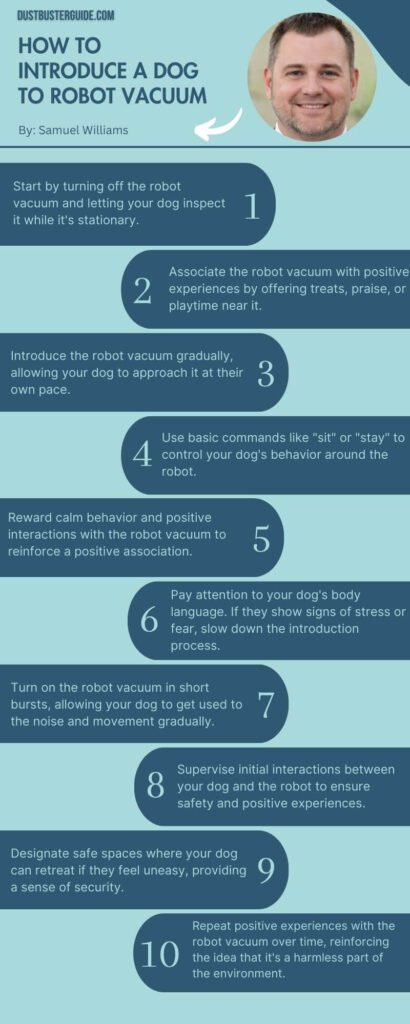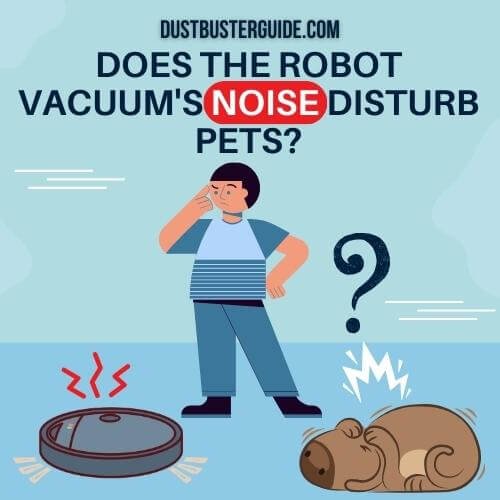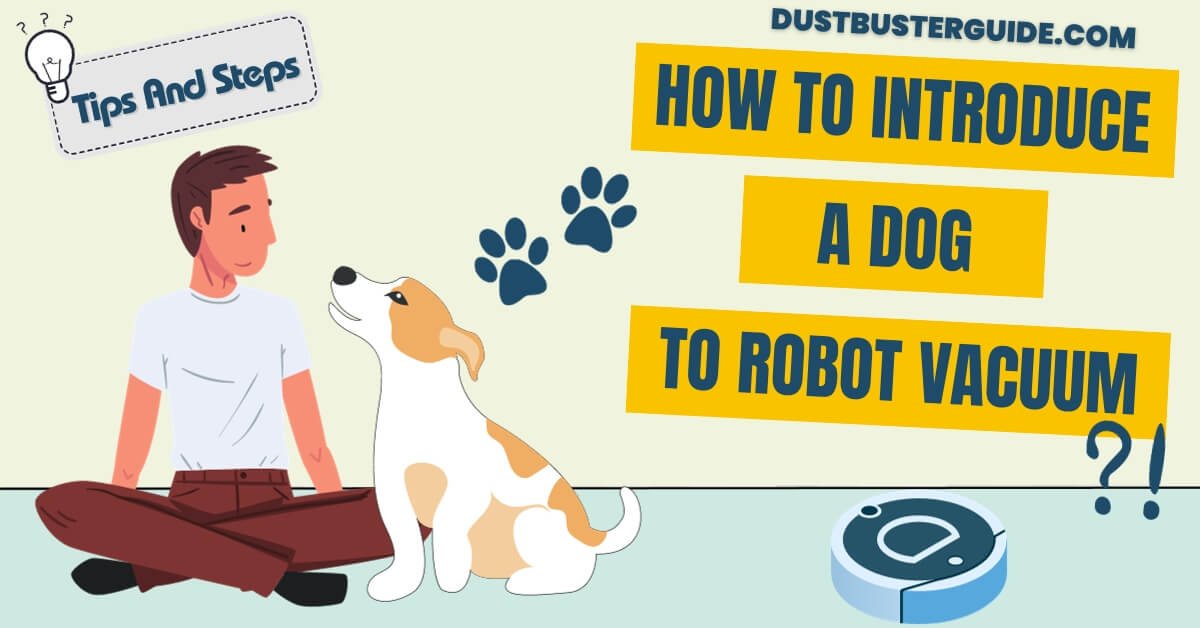Introducing your furry friend to the newest addition to your home, the robot vacuum can be an interesting experience. How to introduce a dog to Robot Vacuum is a question that explores the strategies and steps to ensure a smooth transition for your canine companion.
In just a couple of lines, the answer unfolds like a pet-friendly revelation: Gradually introduce the robot vacuum, let your dog observe from a distance, and use positive reinforcement-like treats to create a positive association. Join us on this exploration for tips on making the introduction of your dog to the robot vacuum a wagging success.
How To Introduce A Dog To Robot Vacuum – Steps Explained
In this section, we’ll guide you step by step, using simple language and helpful tips, on how to introduce your dog to your new robot vacuum. Let’s get started!
First, it’s important to understand why your dog may be afraid of the robot vacuum. Dogs are creatures of habit, and any sudden change or new object in their environment can trigger fear or anxiety. The robot vacuum is a new and unfamiliar object that moves on its own, makes noise, and may seem threatening to your dog.
To help your dog overcome its fear, follow these steps:
- Familiarize your dog with the robot vacuum
- Associate positive experiences with the robot vacuum
- Gradually introduce noise and movement
- Provide a safe space
- Use positive reinforcement
- Be patient and take it slow
Remember, the key to successfully introducing your dog to the robot vacuum is patience, positive reinforcement, and gradual exposure. With time and the right approach, your furry friend will soon see the robot vacuum as just another part of the household. Happy vacuuming!
Let’s now let’s talk in detail about all these important steps to introduce your dog to the Rpbpt vacuum.

What Is Your Pet’s Perception Of The Device
You’ve got to put yourself in your pet’s paws and try to understand how this new, strange, and potentially intimidating device might appear to them. Imagine you’re in your home, your safe haven, and suddenly this weird, noisy object starts moving around on its own. It’s not a creature, but it’s not a toy either. It’s unpredictable and it’s in your territory.
From a dog’s perspective, the robot vacuum can seem like an unwanted intruder or even a potential threat. In their eyes, your home is their territory and they’ve been entrusted with the task of protecting it. So, it’s not surprising that they might be wary or even aggressive towards this new device.
It’s crucial to remember that while we see the robot vacuum as a handy tool, our dogs might see it very differently. Being aware of this can help us better prepare our pets for the introduction of a robot vacuum and prevent any unnecessary stress or anxiety.
How Your Dogs’ First Impressions Matter Should Be
First impressions truly matter when it comes to your furry friend’s initial encounter with a new, moving object in their territory. The key to a successful first introduction between your dog and the robot vacuum is to ensure it’s a positive experience.
Start by placing the vacuum in a neutral location where your dog can safely observe it from a distance. Switch it off so it’s stationary and quiet. Let your dog sniff around it, giving them the chance to familiarize themselves with this strange new object. Reward their curiosity with treats and positive affirmations, like ‘good job’ or ‘well done’.
Once your dog seems comfortable with the vacuum’s presence, turn it on but keep it stationary. The humming noise might startle your dog at first, but reassure them with your calm demeanor and occasional treats. Remember, the goal isn’t to rush this process but to gradually let your dog get used to the sight, sound, and movement of the robot vacuum.
It’s crucial to monitor your dog’s reactions closely throughout this process. If they show signs of distress or fear, switch off the vacuum and give them a break. Always end these sessions on a positive note to keep your dog’s association with the vacuum as friendly as possible.
How To Gradually Familiarizing Your Pet With The Vacuum
Moving on to the next phase, it’s essential to gradually increase your pet’s exposure to the vacuum’s movements. Start by running the robot vacuum in a separate room while your dog is present in the house, but not in the same space. This will allow your dog to get used to the noise without being directly exposed to the movement. Over time, slowly introduce the vacuum into the same space as your dog, but continue to provide a safe space where your dog can retreat if it feels uncomfortable. Always ensure that the first few encounters are short and not overwhelming for your dog.
In the next step, you can start to associate the robot vacuum with positive experiences. For instance, while the vacuum is operating, give your dog a treat or engage in a fun activity. This will help your dog to associate the vacuum with positive things, instead of seeing it as a threat. Also, remember to praise your dog for calm behavior when around the vacuum. Here’s a simple table to help you understand the steps involved:
| Step | Description |
| Step 1 | Start by running the robot vacuum in a separate room or area where your pet doesn’t spend much time. This allows them to hear and see the vacuum from a distance. |
| Step 2 | Slowly introduce the vacuum into the same space as your pet while it’s turned off. Allow your pet to approach and investigate it at their own pace. |
| Step 3 | Associate the vacuum with positive experiences. You can do this by providing treats or playing with your pet near the vacuum, so they begin to see it as a non-threatening presence. |
| Step 4 | Reward calm behavior. If your pet remains calm and relaxed around the vacuum, be sure to reward them with praise and treats. This reinforces the positive association. |
| Step 5 | Gradually increase the vacuum’s operating time. Start with short cleaning sessions and gradually extend them over time. Continue to reward your pet for calm behavior during vacuuming. |
How To Build Positive Associations
Creating a positive association with the vacuum cleaner can make all the difference in your pet’s comfort level. Start by placing treats or your dog’s favorite toys near the robot vacuum when it’s turned off. This way, your furry friend begins to associate the device with good things, gradually decreasing their fear of it.
Be patient and consistent, let your dog approach the vacuum at its own pace without forcing them. Remember, the goal is to have your pet view the vacuum as a non-threatening presence in their environment.
In addition to using treats and toys, you could also try feeding your dog near the vacuum or even play a fun game around it. The key here is to make the experience enjoyable and stress-free for your pet. The vacuum should be part of the background, not the focus of the activity.
Over time, your dog will learn to ignore the vacuum, viewing it as just another household item. This process may take some time, so it’s crucial to be patient and understanding of your pet’s needs.
What Are The Tips And Tricks To Maintaining A Peaceful Coexistence
Navigating the waters of peaceful coexistence between your pet and the cleaning device doesn’t have to feel like an uphill battle. The key is to establish a routine that your pooch can get accustomed to. Start by scheduling the robot vacuum to clean when your dog is either out for a walk or comfortably napping in another room. This can help reduce the initial anxiety they may feel around the new device.
Also, remember to keep the vacuum out of your dog’s reach when not in use, as some dogs might see it as a chew toy.
Here are a few more tips for a seamless transition:
- Keep the vacuum and its charging station out of your dog’s favorite lounging spots.
- Gradually introduce the vacuum to more areas of your home, so your pet has time to adjust at their own pace.
- If your pet seems overly stressed, consider using pet-friendly anxiety aids like calming treats or a comforting pet bed.
- Always monitor the first few interactions between your dog and the robot vacuum to ensure safety.
Remember, patience is key. It might take a while for your dog to get used to the new addition, but with consistent effort and positive reinforcement, your dog and robot vacuum will eventually learn to coexist peacefully.
Does Robot Vacuum Harm Pets
Robot vacuums are generally designed with safety in mind and are not intended to harm pets. However, their impact on pets can vary based on individual temperament and sensitivity.

One important consideration is the noise level of the vacuum, as it can be relatively loud during operation. Some pets may find this noise disturbing, which could lead to anxiety or stress.
Additionally, the unpredictable movement of the robot vacuum might intrigue some pets, prompting them to investigate or even play with it, while others may become frightened and try to avoid it.
It’s essential to monitor your pet’s reactions to the robot vacuum and take steps to ensure their safety and comfort, such as supervising initial interactions, gradually acclimating them to the device, and scheduling cleaning times when they are not in the cleaning area.
Overall, while robot vacuums are generally safe for pets, it’s important to consider your pet’s unique needs and responses when using these devices in your home.
Which Is The Best Robot Vacuum For Pet Hair
Selecting the best robot vacuum for pet hair often involves considering specific features tailored to handling pet-related messes. Models like the iRobot Roomba i7+ come equipped with self-emptying dustbins, which are especially useful for homes with heavy pet hair accumulation.
The Roborock S6 MaxV, on the other hand, stands out for its advanced mapping and obstacle avoidance technology, ensuring efficient cleaning around pet-related clutter.
Additionally, the Neato Botvac D7’s laser-guided mapping provides precise cleaning paths and obstacle avoidance, which can be beneficial for larger homes with pets. When making a decision, it’s crucial to assess your home’s size, the shedding rate of your pets, and any specific features you desire, such as smartphone app control or the ability to set cleaning boundaries.
What Are The Pros And Cons Of Introducing A Dog To A Robot Vacuum
Introducing a dog to a robot vacuum has its pros and cons. On the positive side, some dogs are social animals and may enjoy interacting with the vacuum cleaner.
Additionally, the vacuum can help keep allergens and other messes at bay, contributing to a cleaner environment. However, there are potential downsides to consider.
Some dogs may be afraid of the noise or movement of the vacuum, so it’s important to introduce the vacuum slowly to ensure both the dog and the vacuum are comfortable.
Furthermore, there is a risk that the robot vacuum may run into dog poop, so pet owners need to be cautious and choose a robot vacuum with features such as object detection to avoid such mishaps.
How To Keep Your Dog Safe While Using The Robot Vacuum
Introducing a robot vacuum to your dog can be a challenge, but there are ways to keep your dog safe while using the vacuum.
One way is to let your dog be accustomed to the vacuum’s presence in the home by leaving it visible at all times, so they may think it’s part of your house’s many pieces of furniture. Over time, your dog might get used to the robot vacuum and its movements and be less startled when activated.
Additionally, you can use positive reinforcement techniques such as giving your dog their favorite treats before or after the vacuum does its automated cleaning to help them associate the two activities positively. It’s also important to supervise your dog’s interaction with the robot vacuum to ensure their safety and avoid any accidents, such as the vacuum running over your dog’s tail or paws.
Another way to keep your dog safe while using the robot vacuum is to choose a vacuum with dog safety features, such as obstacle avoidance sensors that can detect and avoid your dog’s tail or paws.
Some robot vacuums, such as the Roomba J7 and Deebot T9, have these features, making them a good choice for pet owners. It’s also important to desensitize your dog to the vacuum’s presence and noise gradually, using positive reinforcement techniques and taking things slow to avoid overwhelming your dog.
Conclusion
So now you know how to introduce a dog to robot vacuum. Remember this is a gradual process. It’s all about patience and understanding your dog’s comfort zone. You’ve made it easier for your furry friend to coexist with the robot vacuum by introducing it gently, creating positive associations, and maintaining a peaceful environment.
Keep these tips handy, and you’ll have a smooth transition. Now, you can enjoy a cleaner home and a less stressed pooch. Here’s to harmonious living with your dog and your robot vacuum!
FAQs
What kind of behaviors can I expect from my dog when first introduced to the robot vacuum?
Your dog may initially show curiosity, fear, or aggression towards the robot vacuum. They might bark, chase it, or try to avoid it completely. It’s important to monitor and manage their reactions to ensure safety.
Are there specific breeds of dogs that may react differently to a robot vacuum?
Yes, dog breeds with herding instincts, like Border Collies, may react more defensively to a robot vacuum. Conversely, laid-back breeds like Bulldogs might be less disturbed. It’s all about their individual personality and temperament.
How can I help my dog overcome its fear if it’s terrified of the vacuum even after several introductions?
If your dog’s still scared of the vacuum after several introductions, don’t worry. Gradually increase exposure, reward their bravery, and create positive associations. Keep sessions short and stress-free. Patience and consistency are key.
What should I do if my dog becomes aggressive towards the robot vacuum?
If your dog shows aggression towards the robot vacuum, don’t panic. Remove them from the room, then gradually reintroduce them to the vacuum while it’s off. Reward calm behavior with treats and praises.
Does the noise level of the vacuum affect how my dog reacts to it, and are there quieter models that could be less intimidating?
Absolutely, the noise level of a vacuum can impact your dog’s reaction. Quieter models might be less scary for them. Look for vacuums specifically designed to operate quietly to keep your furry friend calm.
How do I get my dog to stop barking at the robot vacuum?
To get your dog to stop barking at the robot vacuum, you can gradually acclimate them to the vacuum by associating it with positive experiences, such as treats or play, and using desensitization techniques to reduce their fear and anxiety
What do dogs think vacuums are?
Dogs may perceive vacuums as loud, intimidating, and threatening due to the high-frequency noises and sudden movements. Some dogs may also view vacuums as something to herd or a potentially dangerous intruder, while others may have had negative experiences with vacuums in the past, contributing to their fear and anxiety.

